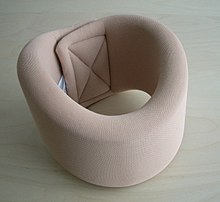Cervical support
A cervical support or cervical support (from Latin cervix , the neck) is a circular neck bandage to relieve the neck structures. This can either be rigid, like the cervical splint (e.g. Stifneck ), or soft and elastic, like the cervical collar .
Cervical splint

Cervical spine splint (cervical spine splint) is a plastic cuff that immobilizes the cervical spine (cervical spine) . It replaces part of the supporting function of the cervical spine and partially deactivates the ability to move. The head rests on the rail, which rests on the shoulders and transfers the weight to them.
For the cervical splint, the product name Stifneck (from English stiff neck ) from Laerdal has established itself . Another well-known product is the Ambu Perfit or Ambu Perfit ACE, which can be stored flat to save space and is manufactured by Ambu . Another alternative name is immobilization collar .
Preclinically , all patients suspected of having a cervical spine injury, especially if a cervical spine fracture is suspected, are put on a cervical splint, for example after a fall from a great height or a traffic accident. It is applied to traumatized patients at the scene of the accident and left in place until a bony injury is excluded. This is to prevent any injury that may exist from being aggravated by moving the affected vertebra.
If an ambulance service employee decides to put on a cervical brace, he may make the suspected diagnosis of "cervical spine fracture", as information about the effects of violence on the cervical spine could have emerged from the (external) medical history, or he puts on the cervical brace because it was him prescribed algorithm or it acts purely prophylactically. It should be noted that a cervical brace does not protect the entire cervical spine from movement and thus manipulation, but only the cervical vertebrae I - V (1–5). However, since the cervical spine consists of a total of seven vertebral bodies and it is not possible to diagnose preclinically whether only one of the first five vertebrae is actually broken, complete immobilization is inevitable.
Everyday life shows that not all employees are aware of this. In the past, the application of a cervical support was considered sufficient to immobilize the cervical spine. This opinion is out of date.
The cervical splints are available in different sizes for babies, children and adults. In the meantime there are also variable models that can be adjusted in size to the length of the neck. To select the correct size, the user thinks of two transverse lines at the tip of the chin, head in neutral position, and over the shoulder, measures this distance with his fingers and transfers it to the cervical splint.
According to the DGU recommendation, if the following five criteria are missing, it can be assumed that there is no unstable spinal injury:
- Impaired consciousness
- neurological deficit
- Spine pain or muscle tension
- Intoxication
- Extremity trauma
The cervical splint protects against
- a nerve-phrenic - paresis
- the entry of the dens axis into the medulla oblongata
The multiple use of the cervical splint is controversial. Presumably for economic and liability reasons, many manufacturers only release the devices for single use.
Ruff
Ruff , Schantz or neck collar denotes a foam or padded plastic collar to reduce neck muscles. Sometimes the terms are also used for the cervical splint .
These soft foam neck supports do not represent immobilization. They are therefore not referred to as “splints”.
In the past, neck braces were often prescribed for whiplash injuries after a rear-end collision. But statistics show that frills make healing worse rather than better.
Individual evidence
- ^ Long version of the guideline "Multiple trauma / treatment of the severely injured" German Society for Trauma Surgery , 2011, page 110

